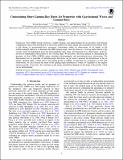Constraining Short Gamma-Ray Burst Jet Properties with Gravitational Waves and Gamma-Rays
Author(s)
Biscoveanu, Sylvia; Thrane, Eric; Vitale, Salvatore
DownloadPublished version (1.934Mb)
Publisher Policy
Publisher Policy
Article is made available in accordance with the publisher's policy and may be subject to US copyright law. Please refer to the publisher's site for terms of use.
Terms of use
Metadata
Show full item recordAbstract
© 2020. The American Astronomical Society. All rights reserved. Gamma-ray burst (GRB) prompt emission is highly beamed, and understanding the jet geometry and beaming configuration can provide information on the poorly understood central engine and circumburst environment. Prior to the advent of gravitational-wave astronomy, astronomers relied on observations of jet breaks in the multiwavelength afterglow to determine the GRB opening angle, since the observer's viewing angle relative to the system cannot be determined from the electromagnetic data alone. Gravitational-wave observations, however, provide an independent measurement of the viewing angle. We describe a Bayesian method for determining the geometry of short GRBs (sGRBs) using coincident electromagnetic and gravitational-wave observations. We demonstrate how an ensemble of multimessenger detections can be used to measure the distributions of the jet energy, opening angle, Lorentz factor, and angular profile of sGRBs; we find that for a population of 100 such observations, we can constrain the mean of the opening angle distribution to within 10° regardless of the angular emission profile. Conversely, the constraint on the energy distribution depends on the shape of the profile, which can be distinguished.
Date issued
2020Department
LIGO (Observatory : Massachusetts Institute of Technology); Massachusetts Institute of Technology. Department of Physics; MIT Kavli Institute for Astrophysics and Space ResearchJournal
Astrophysical Journal
Publisher
American Astronomical Society